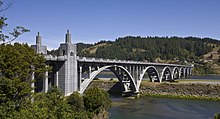Isaac Lee Patterson Bridge
| Isaac Lee Patterson Bridge | |
|---|---|
 |
|
| Coordinates | 42°25′38″N 124°24′48″W / 42.4272°N 124.4133°WCoordinates: 42°25′38″N 124°24′48″W / 42.4272°N 124.4133°W |
| Carries | 2 lanes of |
| Crosses | Rogue River |
| Locale | Gold Beach, Oregon to Wedderburn, Oregon |
| Maintained by | State of Oregon |
| ID number | 01172 009 32764 |
| Characteristics | |
| Design | Concrete arch-deck |
| Total length | 578.5 m (1898 ft) |
| Width | 8.2 m (59.1 ft) |
| Longest span | 70 m (230 ft), 7 spans |
| History | |
| Opened | May 28, 1932 |
| Statistics | |
| Daily traffic | 6200 |
|
Rogue River Bridge No. 01172
|
|
| Location | OR Coast 9, US 101, MP 327.70, Gold Beach, Oregon |
|---|---|
| Area | 2.6 acres (1.1 ha) |
| Built | 1932 |
| MPS | McCullough, C.B., Major Oregon Coast Highway Bridges MPS |
| NRHP Reference # | 05000814 |
| Added to NRHP | August 5, 2005 |
The Isaac Lee Patterson Bridge, also known as the Rogue River Bridge and the Isaac Lee Patterson Memorial Bridge, is a concrete arch bridge that spans the Rogue River in Curry County, Oregon. The bridge carries U.S. Route 101 across the river, near the point where the river empties into the Pacific Ocean, and connects the towns of Gold Beach and Wedderburn. A bridge with strong Art Deco influences, the Isaac Lee Patterson Bridge is a prominent example of the designs of the Oregon bridge designer and highway engineer Conde McCullough. It was designated a National Historic Civil Engineering Landmark by the American Society of Civil Engineers in 1982. It is part of a series of notable bridges designed by McCullough for the Oregon Coast Highway in the 1930s. It was placed on the National Register of Historic Places in 2005.
Work began on the bridge at Gold Beach in 1930. In order to avoid problems with concrete shrinkage that had plagued concrete arch bridges in the past, McCullough used the Freyssinet method of pre-tensioning the arches during construction using hydraulic jacks, using sixteen 250-ton jacks from Freyssinet's firm, enough to work with two arch panels at a time. McCullough's design was the first usage of this technique in the United States. The remote location of the building site presented a significant challenge, with reinforcing steel shipped southward from Port Orford, and built a concrete plant on the north bank of the river. Pilings for the piers were obtained locally. The bridge was planned to open in January 1932, but the ferry Rogue was damaged in December 1931 flooding and the bridge opened early, on December 24, 1931. It was dedicated on May 28, 1932 and named after Isaac Lee Patterson, the governor of Oregon from 1927 to 1929.
...
Wikipedia


